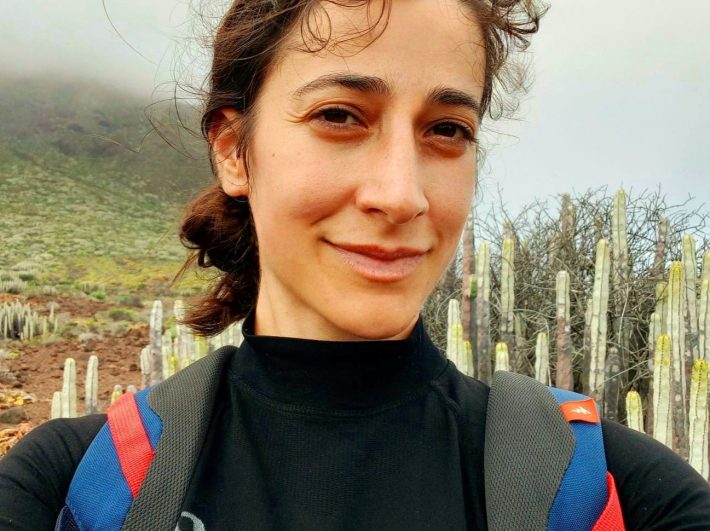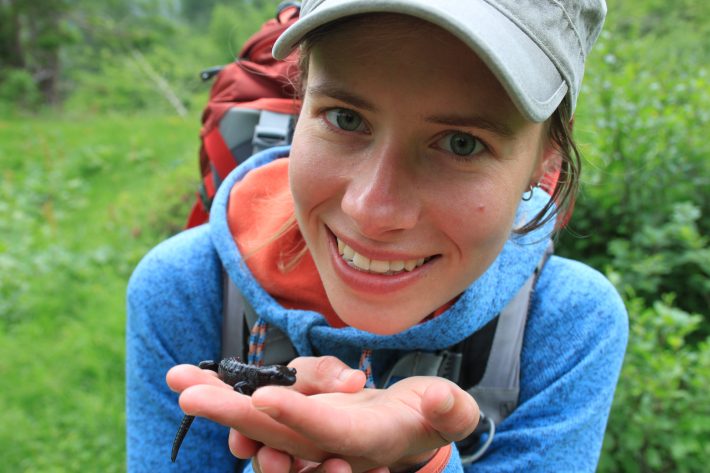Harper Prize
The John L Harper Early Career Researcher Award is given each year to the best paper in the journal by an early career author at the start of their career. In the absence of extenuating circumstances, ‘early career’ is defined as less than 5 years post- Ph.D. or -D.Phil. experience according to the date of your graduation certificate. The winner of the award will receive £500, membership of the BES, a year’s subscription to Journal of Ecology, and a contribution to the costs incurred in attending the BES Annual Meeting in the UK if they wish to give a presentation on their work. The winner is selected by the Editors of Journal of Ecology at the end of each year and an announcement is made early in the New Year following.
If the first author of a paper considers that they are eligible for this award they are invited to nominate themselves during the submission process of Manuscript Central. Those nominated are in the early stages of their research career.
Winner of the Harper Prize 2023

Tyler Coverdale
Unravelling the relationship between plant diversity and vegetation structural complexity: A review and theoretical framework. Tyler C. Coverdale & Andrew B. Davies (Journal of Ecology, 2023,111, pp 1378–1395).
The Journal of Ecology Editors are pleased to award the 2023 Harper Prize to Tyler Coverdale. Transitioning from aquatic to terrestrial environments posed a significant challenge for plants: they had to find ways to deal with overcrowding and maximize light interception in three-dimensional space. As such, the evolution of vertical structural complexity (VSC) became an important component affecting biomass and species diversity in terrestrial ecosystems, especially forests. As Tyler´s succinct review points out, we have examined the consequences of VSC in many ecosystems but have paid less attention to the actual mechanisms for the variation in VSC. Until now. Tyler explores how remote sensing tools document the variation in vertical structuring of canopies, and how VSC relates to ecosystem function. The presented evidence suggests a predominantly positive relationship between plant species diversity and VSC, emphasizing an underappreciated aspect of phytodiversity which may increase structural complexity, ecosystem stability and resistance and resilience to disturbance and global change.
Dr. Tyler Coverdale is an Assistant Professor in the Department of Biological Sciences at the University of Notre Dame. His research aims to understand how species interactions are shaped by a rapidly changing world, and how changes in the abundance and diversity of plants affects the structure, function, and resilience of the world’s ecosystems. Research in Dr. Coverdale’s lab typically involves manipulative field experiments in tropical and temperate ecosystems, particularly African savannas and North American prairies. Dr. Coverdale received his PhD from Princeton University before completing postdoctoral fellowships at Cornell University and Harvard University.
Find the winning paper as well as the shortlisted papers in this virtual issue.
Winner of the Harper Prize 2022

Angela Illuminati
Coordination between water uptake depth and the leaf economic spectrum in a Mediterranean shrubland. Angela Illuminati, José Ignacio Querejeta, Beatriz Pías, Adrián Escudero & Silvia Matesanz. (Journal of Ecology, 2021,110: 8, pp 1844-1856).
The Journal of Ecology Editors are pleased to award the 2022 Harper Prize to Angela Illuminati. Angela’s excellent study more fully characterizes plant ecohydrological niches by integrating water uptake depth with the leaf economics spectrum in a seasonally dry environment. Angela conducted the study in a Mediterranean shrubland with 24 species representing > 90% of species richness at her site. The single sampling effort was carefully timed to coincide with the community’s flowering peak and establishment of a strong vertical gradient in soil water isotope ratios. Species functional diversity was measured in terms of the isotope ratios of xylem water (linking to depth of water uptake), specific leaf area, leaf N, P and K, and leaf carbon, nitrogen oxygen isotope ratios. Using phylogenetic principal components analysis (phylPCA), Angela found that the species primarily separated along a resource strategy spectrum, in which species with resource-acquisitive traits took up more shallow water and species with resource-conservative traits relied more on deep water. Along the second phyPCA axis, species separated along leaf-levels water-use traits, and it was these traits that correlated with species density and cover in the community. Angela’s paper impressed the editors by its experimental design qualities, its clear messaging and an astute discussion touching on implications of her work for whole-plant trait coordination, nutrient competition and community assembly in ecosystems co-limited by nutrients and water.
Angela Illuminati grew up in the Apennines in the centre of Italy. Under pristine skies full of stars, her passion for nature bloomed. As a teenager she loved mathematics, astronomy, and philosophy. She combined her love for nature and science by taking a bachelor’s degree in Natural Sciences (Perugia, Italy), further motivated by ever-growing issues related to environmental pollution and nature conservation. During her early academic years at University, her curiosity was encouraged by her bachelor’s thesis mentor, and she became passionate about plant ecology. She further specialized in this field during her master’s degree at the University of Bologna (Italy) and, after carrying out short stays at different research centres in Europe, she started her PhD thesis in Spain at Rey Juan Carlos University (URJC, Madrid). During her PhD research, she investigated belowground plant-plant and plant-soil interactions in Mediterranean semiarid environments. She fulfilled her PhD with honours in September of 2022 and she is currently a post-doctoral researcher in the Area of Biodiversity and Conservation, URJC.
Find the winning paper as well as the shortlisted papers in this special virtual issue here
Winner of the Harper Prize 2021

Dina in ‘t Zandt
Species abundance fluctuations over 31 years are associated with plant–soil feedback in a species-rich mountain meadow. Dina in ‘t Zandt, Tomáš Herben, Annelien van den Brink, Eric J. W. Visser & Hans de Kroon. (Journal of Ecology, 2021, 109:3, pp 1511-1523).
The Journal of Ecology Editors are pleased to award the 2021 Harper Prize to Dina in ‘t Zandt. Dina’s study is an excellent example of how to match field and experimental greenhouse studies to investigate the role of plant-soil interactions in plant community assembly processes. Using field data from a 31-year survey of a species-rich mountain meadow, Dina and colleagues showed how plant-soil feedback and plant abundance relationships were time-dependent moderated by soil nutrient abundance from manure application. Single point-in-time estimates of the strength of plant-soil feedback relationships were determined in the greenhouse for 24 of the most frequent plant species identified in the field survey. Combined results showed that plant-soil feedbacks are important regulatory mechanisms with negative feedbacks moderating the abundant plant species facilitating co-existence with the less abundant species. Together the results of Dina’s study help explain contrasting results of plant-soil feedbacks reported in the literature reflecting the dynamic nature of plant communities.
Dina in ‘t Zandt grew up in the Netherlands where she was mostly found climbing trees in the local forest and playing football on the muddy pitches. She always felt drawn to nature, forests and mountains in particular. Dina studied biology at Radboud University and specialised in plant ecophysiology during her MSc thesis and Honours Academy projects at Radboud University and ETH Zurich, Switzerland. During her PhD in the group of Hans de Kroon, Radboud University, she studied the role of plant-soil feedback as a driver of plant species co-existence and diversity. After this, Dina did a postdoc in the group of Michael Bahn at the University of Innsbruck, Austria, working on long-term recurrent drought and seasonal asynchrony in mountain grasslands. Currently, Dina is a postdoc in the group of Zuzana Münzbergová at the Czech Academy of Sciences, Průhonice. One of her lines of research focusses on how microbial networks in soil, plant rhizospheres and roots are shaped by plant community stability, plant species competition and soil legacies. Her second line of research targets the effects of temperature, precipitation and long-term recurrent drought on plant-soil-microbiota interactions. Dina currently lives in Ireland and is hosted in the group of Fiona Brennan at Teagasc, Johnstown Castle.
Find the winning paper as well as the shortlisted papers in this special virtual issue here
Winners of the Harper Prize 2020
This year the Journal of Ecology editors are pleased to award our Harper Prize to two exceptionally talented Early Career Researchers, Blanca Arroyo‐Correa and Atul Joshi. These two ECRs have led the research and writing of two outstanding papers that focus on the effects of alien species.

Blanca Arroyo‐Correa
Alien plants and flower visitors disrupt the seasonal dynamics of mutualistic networks. Blanca Arroyo‐Correa, Laura A. Burkle & Carine Emer. (Journal of Ecology, 2020, 108:4, pp 1475-1486)
Blanca Arroyo-Correa’s paper presented results of a novel study investigating the disruptive effects of both alien plants and alien pollinators on temporal changes in plant-pollinator networks. Field data coupled with species removal simulations showed that alien species in both trophic levels led to rewiring and increased species turnover of plant-pollinator networks. Blanca’s paper not only addresses important concepts related to our understanding of the effects of alien species, but it has important conservation implications suggesting that managers need to account for the seasonal dynamics of trophic interactions.

Atul Joshi
Frost maintains forests and grasslands as alternate states in a montane tropical forest–grassland mosaic; but alien tree invasion and warming can disrupt this balance. Atul A. Joshi, Jayashree Ratnam & Mahesh Sankaran. (Journal of Ecology, 2020, 108:1, pp 122-132)
Similarly, Atul Joshi’s paper also shows how alien species can disrupt ecological processes. In this case, Atul and colleagues show that alien species and climate warming can affect the balance between alternate states in a montane tropical forest-grassland mosaic. Fire and herbivory are usually considered to drive forest-grassland transitions. However, through a combination of field germination and seedling survival experiments, Atul showed that frosts and freezing temperatures limit tree establishment into grassland areas of the mosaic. In addition, winter survival of alien Acacia seedlings were less limited than native tree species by cold tropical winter conditions. Future climate warming may change the balance of forests and grasslands in the montane system Atul studied enhancing the invasion of alien Acacia.
You can read both the winning papers, along with all the shortlisted articles in our Harper Prize 2020 virtual issue.
Winner of the Harper Prize 2019

Maria Leunda
Ice cave reveals environmental forcing of long‐term Pyrenean tree line dynamics. Maria Leunda, Penélope González‐Sampériz, Graciela Gil‐Romera, Miguel Bartolomé, Ánchel Belmonte‐Ribas, Daniel Gómez‐García, Petra Kaltenrieder, Juan Manuel Rubiales, Christoph Schwörer, Willy Tinner, César Morales‐Molino & Carlos Sancho. (Journal of Ecology, 2019, 107:2, pp 814-828)
The Journal of Ecology editors are pleased to award the 2019 Harper Prize to Maria Leunda. Maria’s paper is a timely study examining changes in treeline ecotone sensitivity using ice cave deposits from a high-altitude site in the Pyrenees. This study demonstrates changes in treeline and forest community composition over relatively short palaeoecological time scales (millennium). These strong and convincing results could be informative about future climate changes that might occur in the region and perhaps more broadly in the future. The editors appreciated the multiple approach from different proxies and the collaborative nature of the researchers from institutions in both Spain and Switzerland. This paper also features the impressive use of ice caves as natural ecological repositories of information frozen in time and space. Maria and her colleagues have highlighted the importance of trying to conserve these ecological treasures in a warming world.
Maria Leunda grew up in the Basque Country (Spain) and thanks to her parents she discovered her fascination for mountains. Maria´s research focuses on understanding long-term vegetation dynamics in mountain environments to assess the impact of future global change on these fragile ecosystems. Her work involves studying palaeoecological proxies, such as fossil pollen or plant macrofossils deposited in lakes and ice archives, in order to understand the effect of past climatic changes and human activities on mountain vegetation. She developed her PhD at the Pyrenean Institute of Ecology (Spain), under the supervision of Dr. Penélope González-Sampériz and Dr. Graciela Gil-Romera, where she studied local to regional vegetation changes in the Pyrenees. Maria is very grateful to Dr. Carlos Sancho, who inspired her to start working in the amazing world of ice caves. Currently, she is a postdoctoral researcher at the Institute of Plant Sciences of the University of Bern and the Federal Institute of Forest, Snow and Landscape Research (Switzerland) where, together with Dr. Christoph Schwörer, Dr. Christoph Sperisen and Prof. Willy Tinner she is analyzing ancient DNA from subfossil needles to study the impacts of past climate changes on conifer populations and their genetic diversity in the Alps.
Find the winning paper as well as the shortlisted papers in this special virtual issue here.
Winner of the Harper Prize 2018

Rutuja Chitra‐Tarak
The roots of the drought: Hydrology and water uptake strategies mediate forest‐wide demographic response to precipitation. Rutuja Chitra‐Tarak, Laurent Ruiz, Handanakere S. Dattaraja, M. S. Mohan Kumar, Jean Riotte, Hebbalalu S. Suresh, Sean M. McMahon & Raman Sukumar. (Journal of Ecology, 2018, 106:4, pp 1495-1507)
The Journal of Ecology editors are pleased to award the 2018 Harper Prize to Rutuja Chitra-Tarak. Rutuja’s paper is an excellent and novel example of integrating different approaches to answer an important ecological issue. In this case, her study, conducted with six colleagues uses a combination of demographic data, hydrological data, and eco-hydrological modelling to relate tropical tree mortality rates to hydrological niches. In a seasonally dry tropical forest in the Western Ghats biodiversity hotspot in India, 12 common tree species were found to differently partition the hydrological niche by accessing water at different depths. As a result, differences in growth rates and survival reflected their demographic response to periods of drought over multi-annual scales. This work is a clear example of how niche relationships can help us understand species coexistence.
Rutuja notes that droughts resulting from climate change are an emerging risk for forests and that rooting depth and hydraulic architectural differences among species means that each tree species could experience its “own drought”. The methodological approach taken by Rutuja and her colleagues reported in this paper provides a novel way forward for future studies to better understand community-wide rooting strategies emphasizing how belowground processes can affect demographic trade-offs.
Rutuja grew up in the wilder outskirts of small-town Wardha in central India that was, in fact, Mahatma Gandhi’s final political base. She notes that in college a fascinating introduction to evolutionary biology changed her mind about the latter making it a predictive, ‘problem-solvable’ discipline on par with Maths and Physics—her favorite school subjects—yet perhaps more challenging. She received a PhD from the Indian Institute of Science, Bangalore, with her interests drawn by functional and community ecology of forests and sustained through enjoyable collaborative work. Rutuja then went onto to do a post-doc at the Smithsonian Environmental Research Center, USA to test her ideas in a variety of forest types. Now as a post-doctoral researcher at the Los Alamos National Lab in New Mexico, USA she works on devising new ways of estimating functional rooting depths of trees and integrating them into process-based models of forest dynamics so that reliable predictions of forest responses to climate change are made possible.
Find the winning paper as well as the shortlisted papers in this special virtual issue here.
Winner of the Harper Prize 2017

Jenny Zambrano
Neighbourhood defence gene similarity effects on tree performance: a community transcriptomic approach Jenny Zambrano, Yoshiko Iida, Robert Howe, Luxiang Lin, Maria Natalia Umana, Amy Wolf, Samantha J. Worthy, Nathan G. Swenson (Journal of Ecology, 2017, 105:3, pp 616–626)
This paper takes a community functional phylogenomic approach to understand how defence genes drive tree community structure and dynamics.
The Journal of Ecology editors are delighted to award the 2017 Harper Prize to Jenny Zambrano. Jenny’s paper is an excellent and novel example of how a community functional phylogenomic approach can be taken to understand demographic performance of co-occuring species. Demographic data on 21 species in a completely censused 25.6 Ha North American forest plot were chosen for the study. Using recent advances in sequencing and informatics the effect of dissimilarity in 27 plant defence genes among neighbours was quantified from RNA extracted from leaf tissue of greenhouse grown seedlings of each species. For 16 of 27 defence genes, individual growth rates were higher when surrounded by dissimilar heterospecific species, whereas for 4 of 27 defence genes survival rates were increased. Overall, the study shows that similarity in defence genes among neighbours can negatively affect demographic performance consistent with Janzen-Connell type dynamics. The Editors were impressed with how this study shows for the first time how a community transcriptomics framework can supplement functional trait approaches and advance our understanding of the drivers of community structure and function.
Jenny Zambrano grew up in Colombia, in a family of biologists and has always been interested in nature. It was especially forests that caught her eye and her desire to understand the processes that control forest structure and dynamics drove her career path. Jenny’s work involves examining fundamental questions in ecology by testing and integrating population and community ecology theory to better understand and predict the function and stability of forest ecosystems. Currently, Jenny is a postdoctoral fellow at the National Socio-Environmental Synthesis Center (SESYNC) where, under the supervision of Dr Nathan Swenson and Dr William Fagan, she is developing new quantitative methods and concepts, centered in spatial ecology for studying the mechanisms structuring forests.
Read the Virtual Issue bringing together the winning and highly commended papers from all the BES journals in 2015.
Winner of the Harper Prize 2016

Martina Treurnicht
Environmental drivers of demographic variation across the global geographical range of 26 plant species Martina Treurnicht, Jörn Pagel, Karen J. Esler, AnneLise Schutte-Vlok, Henning Nottebrock, Tineke Kraaij, Anthony G. Rebelo, Frank M. Schurr (Journal of Ecology, 104:2, pp 331-342)
The Journal of Ecology Editors are delighted to award the 2016 Harper Prize to Martina Treurnicht. Martina’s paper is an excellent example of a study testing how critical demographic vital rates, namely reproduction and survival, vary in response to the environment across the geographic range of a broad range of species. Twenty-six shrub species in the Proteaceae plant family were chosen for the study. Martina and colleagues collected 3,454 population-level records from across the global range of these species in the Cape Floristic Region of South Africa and used regression analyses to investigate rates of fecundity, recruitment and adult fire survival in response to climate, population density, fire interval, and soil nutrients. Across the range of the species, they found a trade-off between survival and reproduction, and resprouting species survived fire better than non-sprouters. Intraspecific variation in fecundity and recruitment was greater than variation in fire survival. The Editors were impressed with the geographic extent of the study as this is one of only a handful of studies that extend demographic investigations beyond individual populations to contrast environmental drivers for several species from a common, in this case fire-prone, habitat. The challenges of conducting large-scale demographic studies that were overcome in Martina’s work provide a model for future studies.
Martina Treurnicht is intrigued by questions in ‘real-world ecology’ and applied conservation. Her current PhD research, based at Stellenbosch University and supervised by Frank M. Schurr, Jörn Pagel, Karen J. Esler and Jasper Slingsby, aims to understand how large-scale demographic variation and functional traits shape the population dynamics and ecological niches of plants with fire-dependent life cycles. In addressing these aims, Martina has collected extensive demographic- and functional trait data throughout the geographical ranges of her study species.
Beyond her PhD research, Martina is an amateur botanist and conservationist. She is interested in documenting the plant diversity of the Cape Floristic Region biodiversity hotspot and concerned about conserving this region in the face of the current biodiversity crisis and ongoing global change. Martina writes popular articles to communicate her work and create awareness around these issues. Through her everyday-life, Martina aims to build bridges between academia and applied conservation by working with a diverse network of stakeholders (researchers, farmers, naturalists, amateur botanists, civil-society volunteers, school groups and conservation organisations).
Read the Virtual Issue bringing together the winning and highly commended papers from all the BES journals in 2016.
Winner of the Harper Prize 2015
Yuuya Tachiki

A spatially explicit model for flowering time in bamboos: long rhizomes drive the evolution of delayed flowering
Yuuya Tachiki, Akifumi Makita, Yoshihisa Suyama and Akiko Satake (Journal of Ecology, 103:3, pp 585–593)
Yuuya’s paper has been selected for this year’s Harper prize as an excellent example of a mathematical modeling approach to explore a perplexing phenomenon, namely that the vegetative growth period (flowering interval) in bamboos shows a geographic cline from tropical (short-interval) to temperate (long-interval) regions. With his colleagues, Yuuya examined the evolutionary stable flowering interval using a spatially explicit mathematical model to investigate how rhizome length, seed and pollen dispersal and inbreeding influence the evolution of the flowering interval. They found that rhizome length increased flowering interval, seed dispersal range decreased it, but less so at large range sizes, and inbreeding depression led to a longer flowering interval within aggregated genets. Their explanation for these findings proposed a balance between intragenet competition and kin competition among seeds. The Editors were impressed with the rigour of the study and the value of the findings that provide novel evolutionary insights into the reproductive strategy of clonal plants.
Yuuya Tachiki became interested in diverse reproductive behaviors in terrestrial plants whilst at graduate school. He studied mathematical models of the evolution of synchronized and highly variable reproduction (i.e. masting) at Kyushu University under the supervision of Prof. Yoh Iwasa. After completing his PhD, Yuuya became a post-doctoral fellow with Dr. Akiko Satake at Hokkaido University. He explored the role of plant-pathogen feedback to maintain the biodiversity and resist from the invasion of alien plant. He also studied the evolution of monocarpic clonal plants (e.g., bamboo), which resulted in his receipt of the Harper Prize 2015. Currently Yuuya is based Kyushu University as a post-doctoral research fellow and is continuing these projects.
Read the Virtual Issue bringing together the winning and highly commended papers from all the BES journals in 2015.
Winner of the Harper Prize 2014
Michiel Veldhuis
The Editors are pleased to award the 2014 Harper Prize to Michiel Veldhuis for his paper A novel mechanism for grazing lawn formation: large herbivore-induced modification of the plant–soil water balance published with colleagues Ruth A. Howison, Rienk W. Fokkema, Elske Tielens, and Han Olff (Journal of Ecology, volume 102, issue 6, pp. 1506–1517).
Veldhuis’ study investigated the role of large herbivores (e.g. warthog, impala, plains zebra) in creating spatial heterogeneity through the creation of grazing lawns in tropical savanna. Grazing lawns are spatially distinct, intensively grazed areas of stoloniferous grasses often presented as an example of co-evolution between grazers and grazing tolerant grasses. Previous work has proposed that grazing lawns were initiated and maintained in these grasslands through a positive feedback between large grazing herbivores and nutrient-rich lawn grasses. By contrast, Veldhuis and colleagues propose that defoliation and soil compaction may initiate grazing lawns through a change in plant-soil water balance favouring drought-tolerant lawn species. Through careful investigation and measurement they found that grazing lawn soil properties and water balance, and possession of drought-tolerant traits in grazing lawn species (e.g. Digitaria longiflora, Urochloa mosambicensis, Dactyloctenium australe and Sporobolus nitens) were consistent with their hypothesis. Their proposed mechanism of grazing lawn formation is general enough for worldwide applicability, especially for grasslands during dry seasons.
Michiel P. Veldhuis completed his Bachelor’s and Master’s degrees in ecology and evolution at the University of Groningen, The Netherlands. During his Master’s he worked on two different research projects. The first explored the role of seed dispersing rodents (agoutis) in the creation/maintenance of tropical forest tree diversity. This involved tracking dispersing seeds at the Smithsonian Tropical Research Institute on Barro Colorado Island, Panama, under the supervision of Dr. Patrick Jansen and Dr. Roland Kays. The second project took Michiel to the South African savannas of Hluhluwe-iMfolozi Park, which resulted in his receipt of the 2014 Harper Prize. As part of this project he studied herbivore effects on vegetation through changes in soil moisture.
In 2012 he started his PhD at the University of Groningen under the supervision of Prof. Han Olff and Prof. Matty Berg. Michiel is working on the importance of ecological autocatalysis for savanna ecosystem structure. Michiel’s main interests are understanding what factors drive the organization and functioning of ecosystems, focusing on the interplay between abiotic gradients and biotic feedback mechanisms to understand how they’ve shaped ecosystems to what we observe today.
Winner of the Harper Prize 2013
Dr. Nitin Sekar
 The Editors have awarded the 2013 Harper Prize to Dr Nitin Sekar for his paper Waiting for Gajah: an elephant mutualist’s contingency plan for an endangered megafaunal disperser published with Raman Sukumar (Journal of Ecology, Volume 101, issue 6, pp. 1379-1388).
The Editors have awarded the 2013 Harper Prize to Dr Nitin Sekar for his paper Waiting for Gajah: an elephant mutualist’s contingency plan for an endangered megafaunal disperser published with Raman Sukumar (Journal of Ecology, Volume 101, issue 6, pp. 1379-1388).
Dr Nitin Sekar’s paper has been chosen as this year’s Harper Prize winner as an excellent example of well conducted field ecology. With colleague Raman Sukumar, their study rigorously investigated the dispersal ecology of a megafaunal fruit, chalta tree (Dillenia indica), in the face of potential extinction of its principal disperser, the Asian elephant (Elephas maximus). Using a combination of focal tree watches, camera trapping, fruit aging trials, dung seed counts, and germination trials in an Indian tropical moist forest, Sekar and Sukumar were able to demonstrate that although elephants were observed to consume 63% of fruit removed from camera traps, D. indica has a risk-spreading dispersal strategy that will hopefully allow it to persist despite declining numbers of its primary megafaunal disperser.
Nitin Sekar is a doctoral student in Ecology and Evolutionary Biology at Princeton University. He is interested in the functional ecology of endangered species, the links between ecosystem services and poverty, and policy related to wildlife conservation and equitable development in the Global South. His dissertation aims to reveal whether Asian elephants (Elephas maximus) are functionally redundant as seed dispersers in a disturbed forest ecosystem in India. Nitin is also a candidate for an environmental policy certificate from the Woodrow Wilson School and Princeton Environmental Institute, where he researches the Indian government’s scheme to promote voluntary village relocation for tiger conservation.
Winner of the Harper Prize 2012
Dr. Simon Doxford
 The Editors have awarded the 2012 Harper Prize to Dr. Simon Doxford for his paper Changes in the large-scale distribution of plants: extinction, colonisation and the effects of climate published with his supervisor Rob Freckleton.
The Editors have awarded the 2012 Harper Prize to Dr. Simon Doxford for his paper Changes in the large-scale distribution of plants: extinction, colonisation and the effects of climate published with his supervisor Rob Freckleton.
The Journal of Ecology Editors were impressed with how Simon Doxford and his supervisor used novel statistical methods to analyse over six decades of records collected by members of the Botanical Society of the British Isles. They looked at how 1781 plant species distributions changed across the UK. Most plant species disperse slowly and the distribution of 45% of them are affected by climate, especially rainfall and temperature, but this is made more complicated by land use history patterns. Their study convincingly shows how historical distribution data, much of it collected by amateur botanists, can help understand current distribution patterns of plants with a view to predicting future changes.
As an undergraduate Simon studied Plant Sciences at the University of Sheffield (2004-2008) where he first began to become interested in plant ecology. During his final year project Simon began working on large-scale plant distribution data under the supervision of Professor Rob Freckleton.
Simon went on to complete his PhD at the University of Sheffield (2008-2011) where he continued work modelling spatial distribution change in plants examining rates of extinction and colonization over time and the role of habitat and climate in these changes. Simon’s PhD also focused onthe population dynamics of annual plants in sand dunes along spatial and temporal environmental gradients.This work involved establishing field experiments at sand dune sites in Europe where he examined fine scale community interaction, such as those between annual plants and bryophytes. Simon has also carried out greenhouse studies examining the effect of a temperature gradient on developmental timing and plant performance.
After his PhD Simon went on to take up a research assistant role (2011-2012) continuing research into sand dune annuals where he has published work on incorporating measures of population growth and temporal gradients into the existing concepts of the Stress Gradient Hypothesis. This work was carried out with Dr Mark Ooi and Professor Rob Freckleton.
Winner of the Harper Prize 2011
Dr. Ryan Phillips
 The 2011 Harper Prize for the best article published in 2011 in Journal of Ecology by a scientist at the start of his or her career, has been awarded to Ryan Phillips of Kings Park and Botanic Garden, Perth, Western Australia, for his article “Do mycorrhizal symbioses cause rarity in orchids?”, published with Matthew Barrett, Kingsley Dixon and Steve Hopper.
The 2011 Harper Prize for the best article published in 2011 in Journal of Ecology by a scientist at the start of his or her career, has been awarded to Ryan Phillips of Kings Park and Botanic Garden, Perth, Western Australia, for his article “Do mycorrhizal symbioses cause rarity in orchids?”, published with Matthew Barrett, Kingsley Dixon and Steve Hopper.
Orchids are among nature’s most enigmatic terrestrial plants, especially in terms of their relationship with mycorrhizal symbiotic partners. In this fascinating study, Ryan Philips and his colleagues postulated that mycorrhizal specificity may contribute to rarity among members of the charismatic orchid genus Drakaea in Australia. However, by using a combination of in-situ baiting of seed with mycorrhizal fungi, ITS nrDNA sequencing of fungi isolated from adult plants, and in-vitro seed germination studies in the presence of fungal partners, Ryan was able to show that rarity among Drakaea species was more likely to be related to microhabitat, niche and pollination requirements than to mycorrhizal specificity. The Editors thought that the combination of field and laboratory work presented in this paper is an exemplary demonstration of the way in which a difficult ecological problem can be addressed experimentally.
During his undergraduate years Ryan developed an interest in the ecological and evolutionary mechanisms underlying diversification and endemism. Ryan undertook his PhD at The University of Western Australia under the supervision of Stephen Hopper and Kingsley Dixon. The paper selected for the Harper Prize was part of his thesis in which he investigated the role of specialized pollinator and mycorrhizal interactions in causing intrinsic rarity in a genus of sexually deceptive orchids. Currently, Ryan is a post-doctoral research fellow working jointly in the labs of Rod Peakall at Australian National University and Kingsley Dixon at Kings Park and Botanic Gardens. While continuing the ecological studies of orchids initiated during his PhD, Ryan is also undertaking research on speciation mechanisms and floral evolution in sexually deceptive orchids.
Winner of the Harper Prize 2010
Dr. Yann Hautier
 The Harper Award for the best article by a scientist at the start of his or her career published in 2010 inJournal of Ecology is awarded to Yann Hautier from the University of Zurich for his article ‘Modelling the growth of parasitic plants’, published with Andy Hector, Eva Vojtech, Drew Purves and Lindsay Turnbull. This exciting work provides an excellent example of how modelling simple ideas, when combined with analysis of experimental data, can lead to new insights into phenomena which were previously thought to be well understood. Hemiparasitic plants are photosynthetically active, but rely on their hosts for water and nutrients. They can reach extraordinary densities in grasslands and play a key role in maintaining diversity, reducing the dominance of grasses and promoting forbs. It is commonly observed that the combined mass of hosts plus parasites is less than that of the host plants when grown alone, leading farmers to curse the parasite. This yield reduction has been attributed to some decrease in photosynthetic efficiency in the parasitized host or to reduced nitrogen-use efficiency by the parasite. In contrast to this view, Hautier and colleagues simply assume that the system productivity is determined only by the host’s growth, and that this, in turn, depends on host size. In their model, the parasite growth rate, therefore, depends solely on the host growth rate; the parasite simply extracts mass from the host and stores it inactively. This mass no longer contributes to growth; hence it inevitably leads to decreased total productivity as long as host growth is size-dependent. Hautier and his colleagues demonstrate experimentally that the basic premise of their model is correct, and then explore several important corollaries. First, when the parasite is rare (so that hosts are typically either uninfected or infected by a single parasite), parasites should be prudent because removing too much mass from their host will reduce their own future growth. Second, when hosts are infected by several parasites, a Tragedy of the Commons situation will occur, leading to over-exploitation of the hosts. This occurs because the prudent parasite would be outcompeted by a more aggressive parasite that takes a greater fraction of host mass. Leaving resources for your competitors is rarely a good idea.
The Harper Award for the best article by a scientist at the start of his or her career published in 2010 inJournal of Ecology is awarded to Yann Hautier from the University of Zurich for his article ‘Modelling the growth of parasitic plants’, published with Andy Hector, Eva Vojtech, Drew Purves and Lindsay Turnbull. This exciting work provides an excellent example of how modelling simple ideas, when combined with analysis of experimental data, can lead to new insights into phenomena which were previously thought to be well understood. Hemiparasitic plants are photosynthetically active, but rely on their hosts for water and nutrients. They can reach extraordinary densities in grasslands and play a key role in maintaining diversity, reducing the dominance of grasses and promoting forbs. It is commonly observed that the combined mass of hosts plus parasites is less than that of the host plants when grown alone, leading farmers to curse the parasite. This yield reduction has been attributed to some decrease in photosynthetic efficiency in the parasitized host or to reduced nitrogen-use efficiency by the parasite. In contrast to this view, Hautier and colleagues simply assume that the system productivity is determined only by the host’s growth, and that this, in turn, depends on host size. In their model, the parasite growth rate, therefore, depends solely on the host growth rate; the parasite simply extracts mass from the host and stores it inactively. This mass no longer contributes to growth; hence it inevitably leads to decreased total productivity as long as host growth is size-dependent. Hautier and his colleagues demonstrate experimentally that the basic premise of their model is correct, and then explore several important corollaries. First, when the parasite is rare (so that hosts are typically either uninfected or infected by a single parasite), parasites should be prudent because removing too much mass from their host will reduce their own future growth. Second, when hosts are infected by several parasites, a Tragedy of the Commons situation will occur, leading to over-exploitation of the hosts. This occurs because the prudent parasite would be outcompeted by a more aggressive parasite that takes a greater fraction of host mass. Leaving resources for your competitors is rarely a good idea.
Yann started studying grassland plant ecology during his master thesis at the University of Lausanne. With Antoine Guisan he was interested in the changes in reproductive investment with altitude in alpine plants. Yann then moved to the University of Zurich to accomplish his PhD studies with Professor Andy Hector. The paper selected for the Harper Prize 2010 is part of his PhD thesis entitled “Mechanisms of maintenance and restoration of plant diversity” for which he received a PhD thesis award from the University of Zurich. Currently Yann is a postdoctoral fellow with Professor Andy Hector and continues studying grassland community ecology.
Winner of the Harper Prize 2009
Dr. Nina Wurzburger
 The 2009 Prize is awarded to Dr. Nina Wurzburger from Princeton University, Princeton, NJ, USA, for her article ‘Plant litter chemistry and mycorrhizal roots promote a nitrogen feedback in a temperate forest’ (Journal of Ecology – Volume 97, Issue 3, p 528-536), published with Ronald L. Hendrick.
The 2009 Prize is awarded to Dr. Nina Wurzburger from Princeton University, Princeton, NJ, USA, for her article ‘Plant litter chemistry and mycorrhizal roots promote a nitrogen feedback in a temperate forest’ (Journal of Ecology – Volume 97, Issue 3, p 528-536), published with Ronald L. Hendrick.
The Editors selected this really interesting and innovative article because it is one of the few that consider, via a field study, how feedbacks between plant species and soil organisms influence nutrient availability to plants.
Nina first became interested in plant–soil relationships and root symbioses at the University of California, Davis, USA, where she worked with Dr. Caroline Bledsoe in forests of northern California as an undergraduate and an M.S. student. She then earned a Ph.D. from the University of Georgia with Dr. Ronald Hendrick and published this paper from the work she carried out in the southern Appalachians as part of her PhD studies. Currently, Nina is a postdoctoral fellow in Dr. Lars Hedin’s laboratory at Princeton University and collaborates with Drs. Joe Wright and Ben Turner at the Smithsonian Tropical Research Institute. She is exploring the limitation of soil nutrients in the diverse lowland tropical forests of Panama.
Winner of the Harper Prize 2008
Dr. Lucia Vivanco
 The 2008 Prize is awarded to Dr. Lucía Vivanco from the University of Buenos Aires, Argentina (now at the University of California at Irvine, USA) for her article ‘Tree species identity alters litter decomposition through long-term plant and soil interactions in a natural forest ecosystem in Patagonia’ (Journal of Ecology – Volume 96, Issue 4, p 727–736), published with Amy Austin.
The 2008 Prize is awarded to Dr. Lucía Vivanco from the University of Buenos Aires, Argentina (now at the University of California at Irvine, USA) for her article ‘Tree species identity alters litter decomposition through long-term plant and soil interactions in a natural forest ecosystem in Patagonia’ (Journal of Ecology – Volume 96, Issue 4, p 727–736), published with Amy Austin.
The Editors selected this article because of its elegant experimental approach, but also for the importance of its findings with respect to understanding how long-term plant–soil feedbacks regulate decomposition processes and forest dynamics at the ecosystem scale.
Like what we stand for?
Support our mission and help develop the next generation of ecologists by donating to the British Ecological Society.